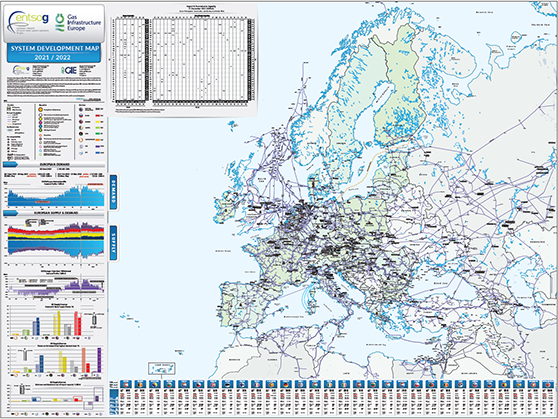January 17, 2023
The new edition of the System Development map, illustrating the latest European gas infrastructure and capacities, was developed by the European Network of Transmission System Operators for Gas (ENTSOG) and Gas Infrastructure Europe (GIE).

GIE – ENTSOG System Development Map 2021/2022
This map is updated on a yearly basis and is a widely used reference for European and non-European stakeholders alike. It provides useful gas market data for enhanced transparency, e.g., 2021-2022 gas supply and demand at both the European and national level. It reflects the current status of the existing and planned European gas infrastructure as of the date of publication.
Piotr Kuś, ENTSOG General Director, commented, “As a consequence of the war in Ukraine, and the subsequent, unprecedented changes affecting the European gas market, the gas TSOs are considering ad-hoc and new projects. Strengthening of the European gas infrastructure is vital for security of supply and market stability, thus full transparency of the current situation is needed. The System Development Map, published jointly by ENTSOG and GIE, is an important tool to reflect the evolution of the gas system.”
Boyana Achovski, GIE Secretary General, reminded: “Fostering solidarity between EU Member States is essential and enhancing market transparency is at the heart of it. EU Gas infrastructure operators, including SSOs LSOs and TSOs, are committed to supporting the EU institutions. With our work and innovation, we strive to establish a more united Europe, and we put efforts into improving the coordination of gas purchases and cross-border exchanges. ENTSOG and GIE welcome feedback from stakeholders and are committed to improving their map over the years.”
The PDF map is available for download at the ENTSOG website, here and GIE website, here. All maps published by ENTSOG and GIE can be ordered in hardcopy format at https://maps.entsog.eu or https://www.gie.eu/map-order.
Should you require any further information, please contact Carmel Carey (carmel.carey@entsog.eu) or Gabrielle Lelievre (gabrielle.lelievre@gie.eu).
Editorial notes
Gas Infrastructure Europe (GIE) is the association representing the interests of European gas infrastructure operators active in gas transmission, gas storage and Liquefied Natural Gas (LNG) regasification. GIE is a trusted partner of European institutions, regulatory bodies and industry stakeholders. It is based in Brussels, the heart of European policymaking. GIE currently represents 70 member companies from 26 countries. GIE’s vision is that by 2050, the gas infrastructure will be the backbone of the new innovative energy system, allowing European citizens to benefit from a secure, efficient and sustainable energy supply.















































